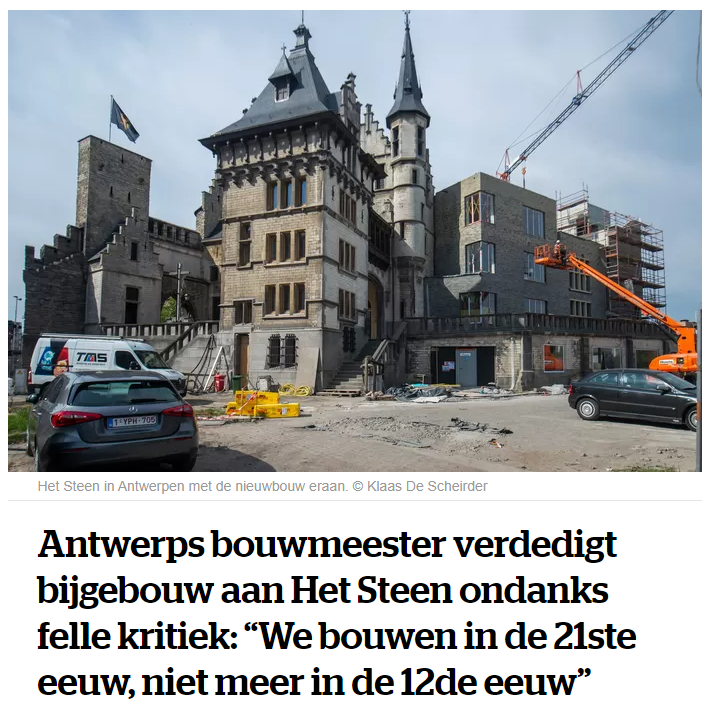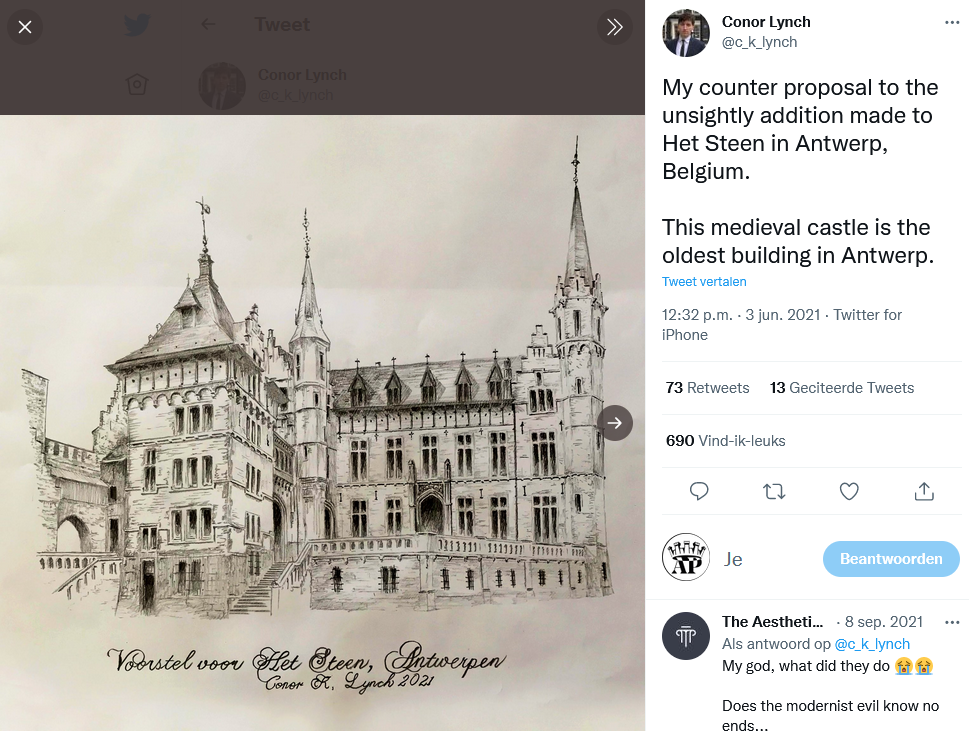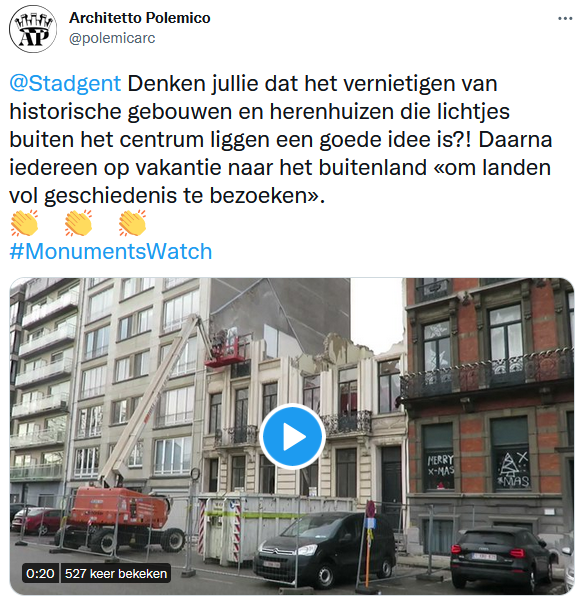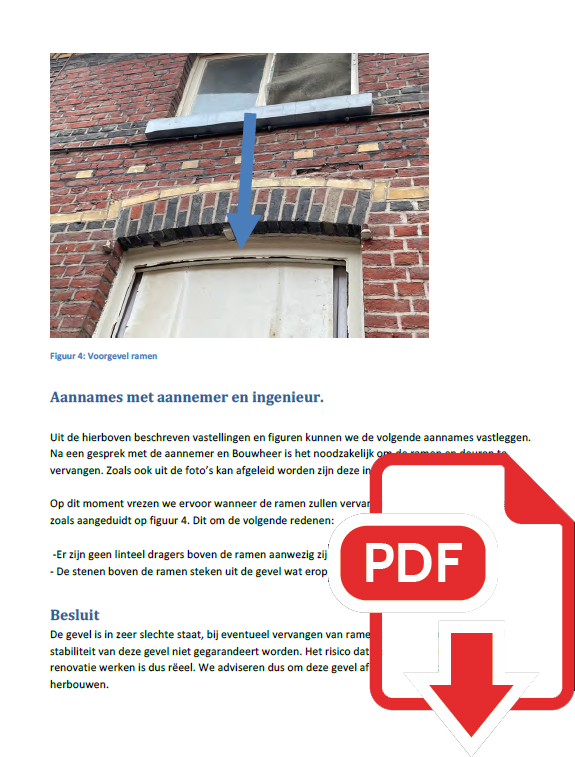Exemplary overview of the dismal state of heritage conservation in Flanders.
This is an overview of various case-studies which, despite being highly local and specific, provide some unconfortable clues on how Heritage (cultural, historical-artistic, architectural...) is managed in the heart of Europe and -consequently- in almost all European countries.
Thanks to the powerful means of the international network of Tradition's admirers and lovers, we're here today to tell this story and, by making it public, ask for your help to sensitize people on the subject and apprising the institutions of our outrage.
This is an overview of various case-studies which, despite being highly local and specific, provide some unconfortable clues on how Heritage (cultural, historical-artistic, architectural...) is managed in the heart of Europe and -consequently- in almost all European countries.
Thanks to the powerful means of the international network of Tradition's admirers and lovers, we're here today to tell this story and, by making it public, ask for your help to sensitize people on the subject and apprising the institutions of our outrage.
For those who want to go straight to the point, I recommend skipping the Foreword. For those who want a bit of context it is instead useful to continue reading.
Foreword
Nowadays we have a very questionable type of theoretical approach to what in these surroundings is called «erfgoed» or «hereditary good» to be passed on to future generations.
A project that has aroused bitter controversy is the extension of Het Steen fortified complex. It is representative of the current approach to Heritage in the EU, that is that "additive" trend that seeks the (anti) philological raison d'être of the intervention in the "contrast" of construction technologies and materials with the existing one.
A project that has aroused bitter controversy is the extension of Het Steen fortified complex. It is representative of the current approach to Heritage in the EU, that is that "additive" trend that seeks the (anti) philological raison d'être of the intervention in the "contrast" of construction technologies and materials with the existing one.
The effect that is displayed is that of "parasitizing" in various measures and ways - often openly claimed - the historical substrate, used only as a pedestal for the contemporary intervention and treated without respect.
[click for the article]
Some international tweeters of great value such as @c_k_lynch have shown with a simple charcoal drawing (that every architect SHOULD be able to draw) the existence of a completely antithetical approach, as well as the many possible alternatives.
[click for the tweet]
Better? Worse? Let's open a debate ...because there's none.
Technocracy decides and the peoples are faced with a fait accompli.
Technocracy decides and the peoples are faced with a fait accompli.
This scandal is consumed while a similar intervention at the Gravensteen castle in Ghent, the capital of the Province of East Flanders a few kilometers away, is averted by a publicly signed letter addressed to the (cough...cough...liberal and progressive) mayor.
Simultaneously, in the nearby Sint-Niklaas, they persevere:
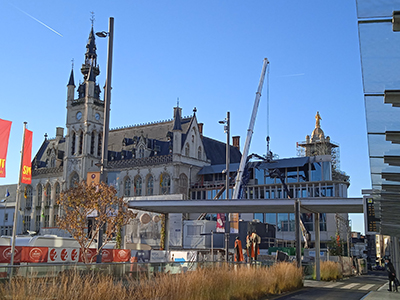
It applies to monuments but, as we will see, this phenomenon is replicated at small scale in the minuscule fabric of urbanity, the one bearing cultural information and historical traces that give character to a street, a glimpse of a town.
And just in these days this news comes out here: in another of the landmarks of Ghent —this time the Duivelsteen fortified residence— after long ups-and-downs they managed to obtain the permits to convert it to exclusive luxury apartments. Well, I don't know, but as a Gentenaar citizen I would have appreciated more a museum or something cultural (which I would not be able to access anyway because I lack of the Governmental Pass as I am not vaccinated for COVID-19 by virtue of my ability not to get sick hardly ever. Long live apartheid public health).
In short, this is the situation.
The sensitivity towards the typical urban fabric, which expresses local identity and personalities, is at an all-time low, we can say it oud loud. At least at the institutional level, which is what determines all the things we are talking about.
On an individual level, things change a lot, as shown for example by our excellent @CharlestonArchi who shows us an interesting survey conducted on the US public. It would be interesting to have a similar one here in Europe.
[click for the tweet]
I invite you to visit other roaring articles in defense of the historical-cultural heritage —well polemicizing and divisive in their critique of Puritan-Taliban-Woke revisionism and iconoclastic fervor, following the tag @MonumentsWatch which evokes the concepts of Victor Hugo's famous «War on the Demolishers». Steadily reminding you that the main site is always the one in Italian.
We are witnessing uncontrolled demolitions and reckless "renovations" of buildings that are objectively valuable and often in perfect conditions, in order to replace them with buildings of inferior construction and aesthetic quality, characterless and in reality very unsustainable.
Within the framework of a substantial regulatory opacity, if not conceptual erroneousness of the standards themselves, not only public bodies but also private individuals operate as cogs in an infernal machine, often in the form of building contractors/entrepreneurs in the "buy-renovate-resell" operational style. They have no interest in relating to existing buildings in a sensitive and personalized way, but they apply systematic industrial and financial standards that are reflected in an aesthetic that can be summed up with "white cube".
There would also be a further cultural aspect, on which I do not linger but which is of not negligible importance, for which the ancestral link with the Territory of the subjects operating in this way is close to zero. It would be interesting to investigate the reasons, perhaps on another occasion.
This state of affairs is made possible by a network of bureaucratic tunnels, elephantine offices, nebulous legal definitions, arbitrariness of public officials and above all by much, muuuuch money channeled through the "redevelopments" connected to the Green New Deal (of which we were already talking very badly as a plague here).
But, by dint of "insignificant" changes in the everyday practical/physical situation, at the humble and minute scale of the single building, then are the aesthetics and the forma urbis also changed radically. It is legitimate to ask ourselves how much control we really have on this phenomenon, if our cities are aesthetically managed correctly, also evaluating if the Heritage is in danger (perhaps checking on the areas, whether low-emission, limited-traffic or not...).
Personally I have seen this phenomenon taking place everywhere in Western Europe and less in the Near East (Eastern Europe) where we are witnessing in part a revival of traditional techniques and aesthetics. Therefore sometimes I feel the need to shoot buckshot when they make this type of proposal in Italy.
Personally I have seen this phenomenon taking place everywhere in Western Europe and less in the Near East (Eastern Europe) where we are witnessing in part a revival of traditional techniques and aesthetics. Therefore sometimes I feel the need to shoot buckshot when they make this type of proposal in Italy.
We were saying that on the scale of the single building, here in Flanders, all kinds of mad things happen. Here is me freaking out against the "competent" Institutions at the umpteenth demolition:
[click for the Tweet]
What usually happens I'll explain to you through the captions of the photos in this mini-gallery:
...and now, before continuing to the interesting part of this post, I present you this building:
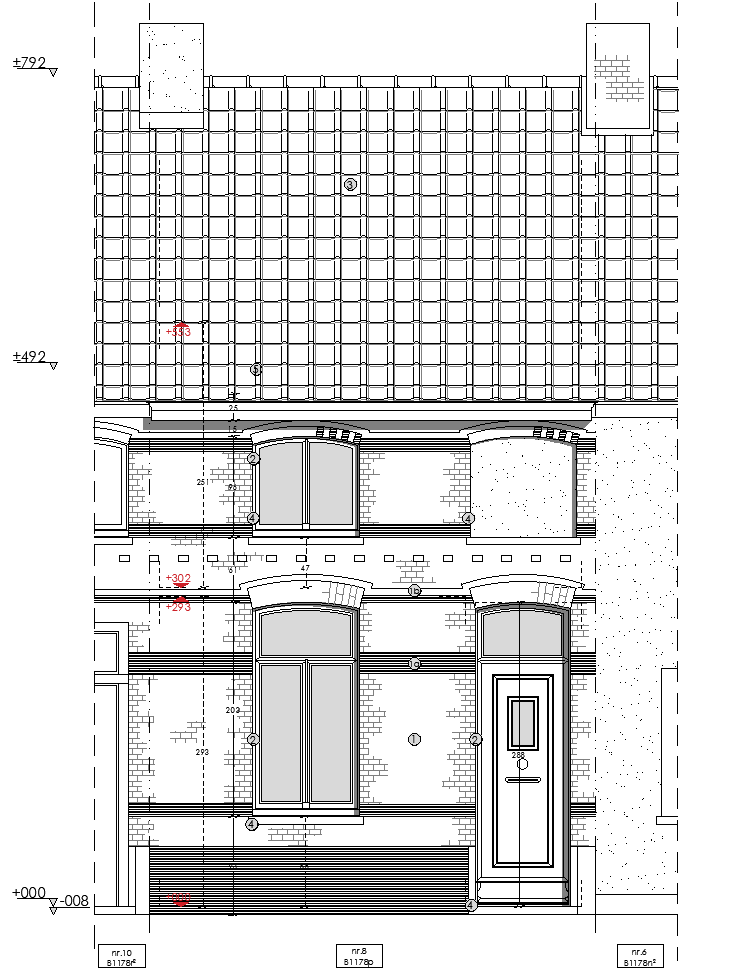
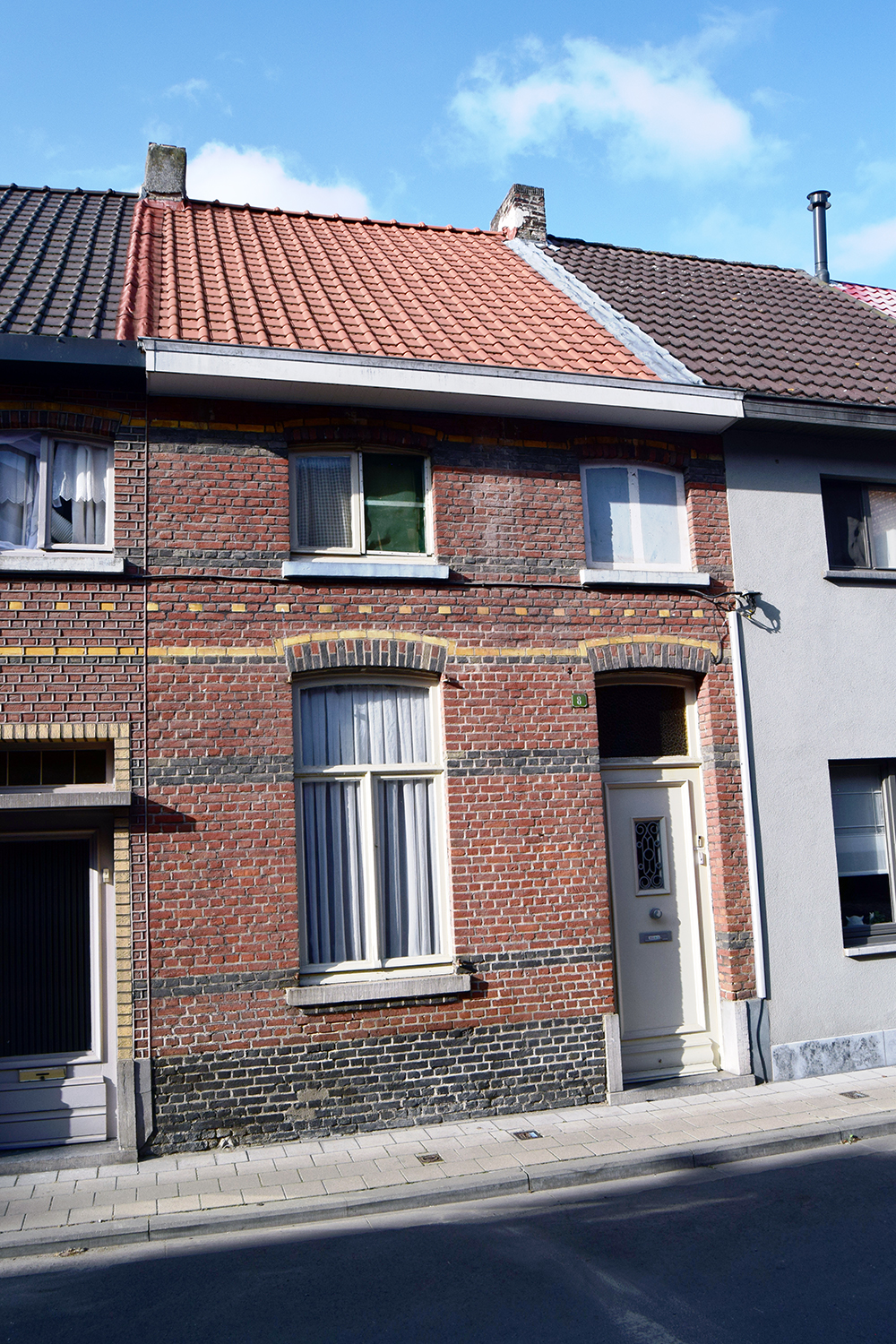
Building Whistleblowing
Premise: I'm in possession of all the documents that can prove what follows. All documents have been anonymised in order to preserve the privacy of the subjects involved and not to expose the "information source".
We are in Hamme, a charming countryside town in the whereabouts of Ghent, where one of these entrepreneurs of the type previously outlined buys without thinking too much an old red brick rowhouse, of the kind used by proletarian workers up to the 1960s and dating back to the early Twentieth Century.
Our individual, of foreign origin, saw a moldy pile of cracked bricks to be transformed into a shiny cube house of easy execution, mediocre finish and quick resale to a medium-low consumer target, probably indebted up to their neck for the purchase.
Unfortunately he had not reckoned with Onroerend Erfgoed (a body supposed to protect the Heritage, but without a ministerial degree) and with a distracted notary who failed to report the protection conferred on the facade by the status of Heritage in the deed of sale.
Our individual, of foreign origin, saw a moldy pile of cracked bricks to be transformed into a shiny cube house of easy execution, mediocre finish and quick resale to a medium-low consumer target, probably indebted up to their neck for the purchase.
Unfortunately he had not reckoned with Onroerend Erfgoed (a body supposed to protect the Heritage, but without a ministerial degree) and with a distracted notary who failed to report the protection conferred on the facade by the status of Heritage in the deed of sale.
[click for the page]
Which page informs us that:
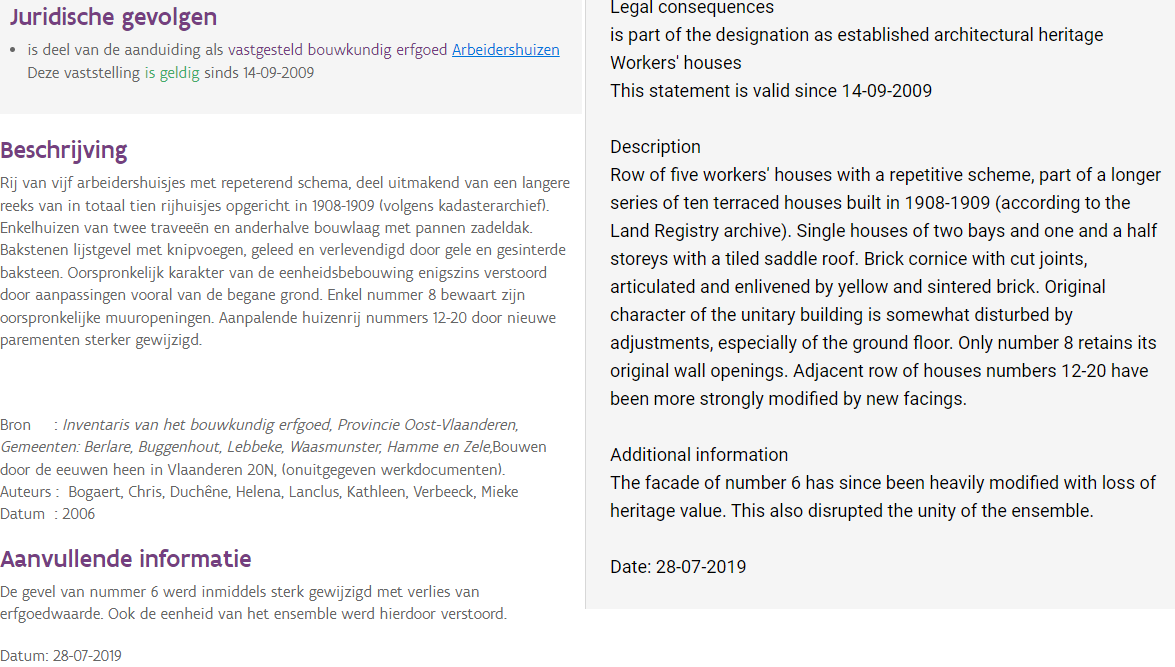
Protected facade, demolition out of the question, end of the story? Of course not. We are in Belgium, the country with three governments, likewise three languages, a King (with many illegitimate heirs), and fifteen hundred beers.
As it happens, for unfathomable reasons, the only house to have «an original and unchanged facade» -ours!- is as protected as the adjoining modified "sisters" (except the one with the plastered facade which has not retained its protected status following that intervention). Our entrepreneur, lacking the cultural sensitivity to find that facade beautiful (i.e. appreciate its value and then derive a commensurate economic profit), reasons as follows:
«If the neighbours could modify their facade, I'm also going to do that».
And so begins an exhausting loop of communications with the various institutions at the end of which the following verdict is issued:
«Dear, you cannot demolish that facade because the building is protected.
BUT
if you give us the expertise of an architect and an engineer who say that the wall is unstable, then you can demolish it even if it is protected, it doesn't matter, just submit a new permit application».
if you give us the expertise of an architect and an engineer who say that the wall is unstable, then you can demolish it even if it is protected, it doesn't matter, just submit a new permit application».

From this picture is possible to notice the difference between 'our' unchanged facade and the others of the group, modified.
Said and done: Our Guy contacts an engineer and an architect, tells them what to write, and they write it.
The engineer edits a "structural report", and the architect timidly echoes it.
The engineer edits a "structural report", and the architect timidly echoes it.
Architect's communication:

[click to enlarge]
The facade was protected. The entrepreneur de cuius had received permission to make the building several meters deeper on the ground floor, so it would not have been a problem to preserve the facade by building an additional insulated wall just behind it, losing a meager square meter of floor space.
Instead, Our Man decides from the beginning to knock everything down, and in doing so he uses very rude manners to remove the floor beams... In this way he forces out some bricks from the facade, on both internal and external sides.
He then instructs the engineer to blame the wall itself, because it is old and so on, as shown in the structural report.
In the meanwhile the architect insists on the aestethical imperfection of repairs (ignoring the existence of dozens of specialized companies).
Instead, Our Man decides from the beginning to knock everything down, and in doing so he uses very rude manners to remove the floor beams... In this way he forces out some bricks from the facade, on both internal and external sides.
He then instructs the engineer to blame the wall itself, because it is old and so on, as shown in the structural report.
In the meanwhile the architect insists on the aestethical imperfection of repairs (ignoring the existence of dozens of specialized companies).
At this point, a whistleblower who has seen all of these things happening decides to send an anonymous email to Hamme's technical office denouncing the incident because, my friends, this type of reporting in Belgium is done by inserting the ID card in the digital reader, and maybe for some the consequences can create problems.
(automatic Google translation:

Thanks to the word of mouth I get to know the events, I can contact the right people, and here we are, writing.
At the last second I also got some photos NOT INCLUDED in the "technical report", which once again show the violent carelessness of our "entrepreneur", as well as certain "slight inaccuracies" In the report ... (the resolution is what it is ...):
What is Manneke essentially asking?
• That the aesthetics and history of his hamlet are respected;
• That the entrepreneur's profits take the back seat in favor of the intangible values of the local landscape;
• That the entrepreneur himself tries to get a good medium/high-end real estate project out of a typical Flemish house, instead of turning it into a mediocre Saudi bunker for digital nomads.
And it is in this precise moment that *we*, the Polemico, intervene by writing and publishing this article with the collaboration of some friends who can guarantee an adequate media coverage and indeed eyes and ears wide open. Otherwise, with my few but avid readers, do not reach the desired levels of controversy and polemics!
But the real point is: is that facade recoverable even if it is damaged? In the opinion of many, yes.
Is it possible to make a project that includes it? Yup!
Is it officially protected as a historic building heritage? Indeed!
And then, as we always repeat, Architecture Is Politics, (and the main site is the Italian one) and what is happening is a political choice of cancel culture that we must oppose, proposing alternative projects and visions that guarantee beauty and identity.
Is it possible to make a project that includes it? Yup!
Is it officially protected as a historic building heritage? Indeed!
And then, as we always repeat, Architecture Is Politics, (and the main site is the Italian one) and what is happening is a political choice of cancel culture that we must oppose, proposing alternative projects and visions that guarantee beauty and identity.
I therefore invite you to send the following message to the municipality of Hamme to remind them of the respect for the local aesthetic history of places, which gives identity to these small towns that would otherwise disappear swallowed up in the totalizing global homologation:
vergunningen@hamme.be
Dear Municipality of Hamme,
Please keep into consideration maintaining the heritage façade in Bareelstraat nr.8 for its intrinsic value,
as it is a typical Flemish feature contributing to the streetscape identity of your town and region.
I believe such aesthetical values should be maintained to contribute to the present and future identity of every place and its inhabitants.
Thank you
Please keep into consideration maintaining the heritage façade in Bareelstraat nr.8 for its intrinsic value,
as it is a typical Flemish feature contributing to the streetscape identity of your town and region.
I believe such aesthetical values should be maintained to contribute to the present and future identity of every place and its inhabitants.
Thank you

Posted: 17/02/2022 17:17 — Author(s): Polemicarc
x
Responses
Anonymous 12/03/2022 02:14
Any news from the Municipality of Hamme? Do you know how many letters were sent about Flemish eritage?
I sent one, I wonder if they are sensible or not at all. Please update....
Thank you
I sent one, I wonder if they are sensible or not at all. Please update....
Thank you
